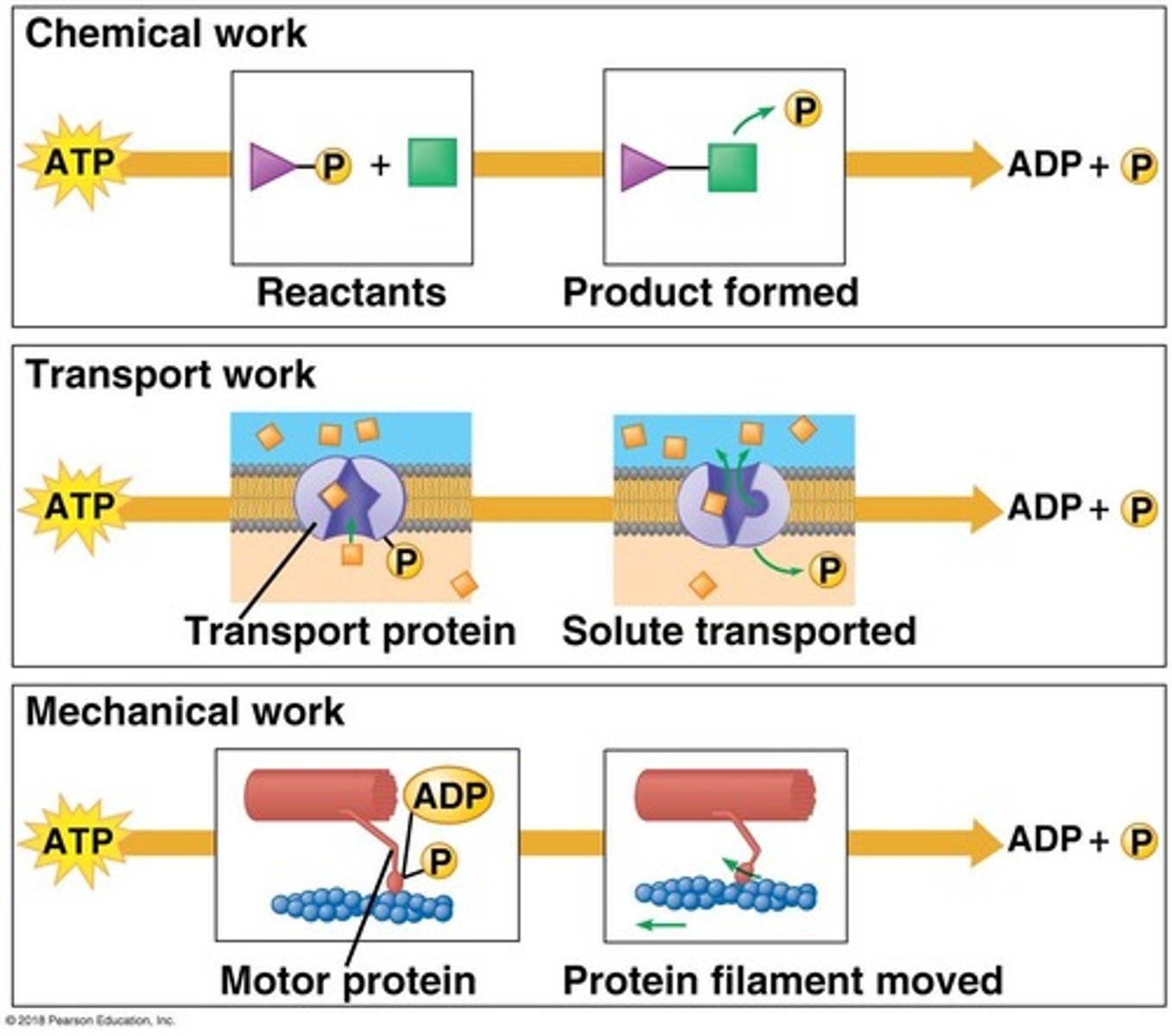Energy Transformations in Cellular Processes
1/66
There's no tags or description
Looks like no tags are added yet.
Name | Mastery | Learn | Test | Matching | Spaced |
|---|
No study sessions yet.
67 Terms
First Law of Thermodynamics
Energy cannot be created or destroyed.
Kinetic Energy
Energy of motion, like heat from an oven.
Chemical Energy
Energy stored in chemical bonds, like in cake.
Entropy
Measure of disorder in a system.
Endergonic Reaction
Reaction that absorbs energy, requiring input.
Exergonic Reaction
Reaction that releases energy, producing work.
Condensation Reaction
Process forming bonds by releasing water.
ATP
Adenosine triphosphate, energy currency of cells.

Activation Energy
Minimum energy needed for a reaction to occur.
Competitive Inhibitor
Substance that binds to active site of enzyme.
Irreversible Inhibitor
Substance that permanently disables enzyme activity.
Non-competitive Inhibitor
Substance that binds to enzyme, not active site.
Negative Feedback Loop
Process where output inhibits its own production.
Glycolysis
First step in cellular respiration, breaking down glucose.
Polymers
Large molecules made of repeating monomer units.
Monomers
Small building blocks of polymers.
Nerve Gas
Irreversible inhibitor affecting nervous system enzymes.
Penicillin
Antibiotic that inhibits bacterial cell wall synthesis.
Energy Transfer
Process of converting energy from one form to another.
Photosynthesis
Process by which plants convert sunlight into energy.
Thermodynamic Efficiency
Measure of energy transfer efficiency in biological systems.
Glycolysis
Breakdown of glucose into pyruvate, producing ATP.
Fructose 1,6-bisphosphate
Intermediate formed from glucose in glycolysis.
Pyruvate
End product of glycolysis, transported to mitochondria.
Acetyl CoA
Product of pyruvate breakdown, enters citric acid cycle.
Citric Acid Cycle
Series of reactions producing energy carriers from Acetyl CoA.
NADH
Electron carrier produced in glycolysis and citric acid cycle.
FADH2
Electron carrier produced in citric acid cycle.
Oxaloacetate
Reactant in citric acid cycle, regenerated each cycle.
Electron Transport Chain
Final step of respiration, generates ATP using electrons.
ATP
Energy currency produced during glycolysis and citric acid cycle.
GTP
Energy molecule produced in citric acid cycle, similar to ATP.
Carbon Dioxide (CO2)
Waste product of pyruvate breakdown and citric acid cycle.
Cyanide
Inhibitor of complex IV in electron transport chain.
Alternative oxidase
Cyanide-resistant pathway in plants for electron transport.
NAD+
Oxidized form of NADH, accepts electrons during reactions.
CoA-SH
Coenzyme aiding in the conversion of pyruvate to Acetyl CoA.
Intermembrane space
Location where protons are pumped during electron transport.
Mitochondrial matrix
Site of pyruvate breakdown and citric acid cycle.
ATP Yield
Approximately 38 ATP produced from one glucose molecule.
Hydrogen ions (H+)
Protons involved in ATP synthesis during electron transport.
Glycolysis Products
2 ATP, 2 NADH, and 2 pyruvate produced in cytosol.
Oxidation
Loss of electrons, as seen in NAD+ to NADH.
Reduction
Gain of electrons, converting NAD+ to NADH.
Electron Transport Chain
Pumps H+ to create electrochemical gradient for ATP.
Alternative Oxidase
Bypasses Complex IV, accepts electrons without cyanide.
Symplocarpus foetidus
Plant that melts snow using alternative oxidase.
Reactive Oxygen Species (ROS)
Harmful byproducts reduced by alternative oxidase pathway.
Substrate-Level Phosphorylation
Direct ATP production in glycolysis and CAC.
Chemiosmotic Phosphorylation
ATP generation via electron transport chain process.
Glycolysis
Breaks down glucose to produce pyruvate and ATP.
Citric Acid Cycle (CAC)
Processes acetyl-CoA to generate ATP and NADH.
Fermentation
Converts pyruvate to lactate when oxygen is absent.
Lactate
Product of pyruvate reaction with NADH in muscles.
Photosynthesis Ingredients
Light, CO2, and water are essential for process.
Photosynthesis Goal
Produce glucose for cellular respiration, not O2.
Absorption Spectra
Plants absorb blue/red light, reflect green light.
Z Scheme
Describes light reactions' energy flow in photosynthesis.
NADPH
Produced in light reactions, used in Calvin Cycle.
ATP Synthase
Enzyme that synthesizes ATP from H+ flow.
Calvin Cycle
Uses ATP and NADPH to produce glucose.
Rubisco
Enzyme in Calvin Cycle affected by temperature.
Cold Temperature Effect
Slows Calvin Cycle due to enzyme affinity changes.
Excess ATP/NADPH
Result from light reactions outpacing Calvin Cycle.
Photosynthesis Model
Illustrates inputs/outputs of light reactions and Calvin Cycle.
Pyruvate Breakdown
Necessary for CAC, requires fats and proteins.
Dietary Variety Importance
Essential for cellular respiration beyond just glucose.